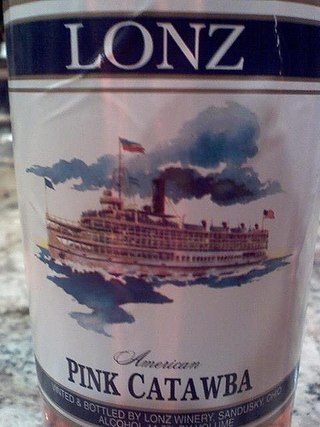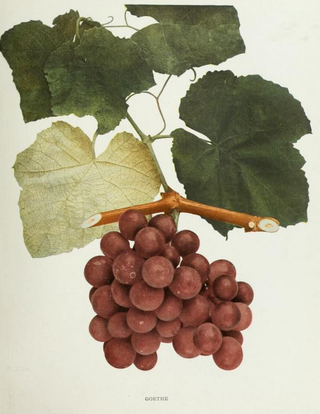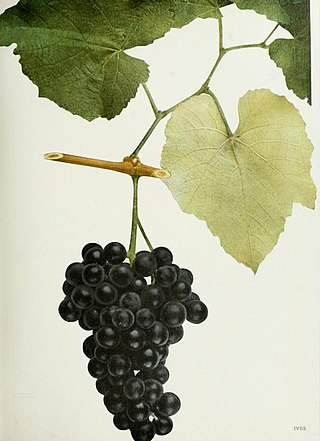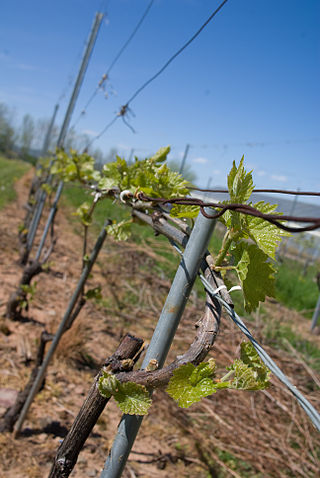
Aurore is a white complex hybrid grape variety produced by Albert Seibel and used for wine production mostly in the United States and Canada. Over a long lifetime Seibel produced many complex hybrid crosses of Vitis vinifera to American grapes. It is a cross of Seibel 788 and Seibel 29.

Catawba is a red American grape variety used for wine as well as juice, jams and jellies. The grape can have a pronounced musky or "foxy" flavor. Grown predominantly on the East Coast of the United States, this purplish-red grape is a likely a hybrid of the native American Vitis labrusca and the Vitis vinifera cultivar Semillon. Its exact origins are unclear but it seems to have originated somewhere on the East coast from the Carolinas to Maryland.

Vitis labrusca, the fox grape, is a species of grapevines belonging to the Vitis genus in the flowering plant family Vitaceae. The vines are native to eastern North America and are the source of many grape cultivars, including Catawba, Concord, Delaware, Isabella, Niagara, and many hybrid grape varieties such as Agawam, Alexander and Onaka. Among the characteristics of this vine species in contrast to the European wine grape Vitis vinifera are its "slip-skin" that allows the skin of the grape berries to easily slip off when squeezed, instead of crushing the pulp, and the presence of tendrils on every node of the cane. Another contrast with European vinifera is the characteristic "foxy" musk of V. labrusca, best known to most people through the Concord grape. This musk is not related to the mammalian fox, but rather to the strong, earthy aromas characteristic of the grapes that were known by early European-American settlers in the New World. The term "foxy" became a sort of catchall for the wine tasting descriptors used for these American wines that were distinct from the familiar flavors of the European viniferous wines.
Cayuga White is a mid-season ripening wine grape developed from crosses of the Vitis labrusca hybrids Schuyler and Seyval Blanc at Cornell University's New York State Agricultural Experiment Station in Geneva, New York. It is a hardy vine with some bunch-rot disease resistance. In warmer climates it should be picked at lower sugars to avoid overripe, sometimes labrusca-like, flavors; however this has not been observed in cooler climates such as the Finger Lakes and Pacific Northwest, where desirable, Riesling-type flavors are tasted in fully ripe Cayuga fruit. Picked at the proper time, it can produce a very nice sparkling wine with good acid balance, structure, and pleasant aromas, or a fruity white wine similar to a Riesling or Viognier. One advantage of Cayuga is that, if harvested unripe, it can still make a good wine, albeit one with more green apple flavors in that case.

Vitis amurensis, the Amur grape, is a species of grape native to the Asian continent. Its name comes from the Amur Valley in Russia and China.

Hybrid grapes are grape varieties that are the product of a crossing of two or more Vitis species. This is in contrast to crossings between grape varieties of the same species, typically Vitis vinifera, the European grapevine. Hybrid grapes are also referred to as inter-species crossings or "Modern Varieties." Due to their often excellent tolerance to powdery mildew, other fungal diseases, nematodes, and phylloxera, hybrid varieties have, to some extent, become a renewed focus for European breeding programs. The recently developed varieties are examples of newer hybrid grape varieties for European viticulturalists. Several North American breeding programs, such as those at Cornell and the University of Minnesota, focus exclusively on hybrid grapes, with active and successful programs, having created hundreds if not thousands of new varieties.
Rogers' Hybrids are a group of 45 grape seedlings, thirteen of them named as cultivars, developed by Edward Staniford Rogers of Salem, Massachusetts, in the mid-19th century. Although mostly gone from cultivation now, their success, along with that of the Concord grape, inspired many amateurs to try grape breeding, resulting in massive proliferation in the number of grape cultivars in the eastern United States and Canada.

Herbert is one of the collection of grape varieties known as Rogers' Hybrids, created by E.S. Rogers in the mid-19th century, and is the result of a cross of Carter, a selection of Vitis labrusca, and Black Hamburg, a selection of Vitis vinifera. It was originally known as Rogers No. 44.

Goethe is one of the collection of grape varieties known as Rogers' Hybrids, created by E.S. Rogers in the mid-19th century, and is the result of a cross of Carter, a selection of Vitis labrusca, and Black Hamburg, a selection of Vitis vinifera. It was originally known as Rogers No. 1, until Rogers named it after Johann Wolfgang Goethe, the German author, artist, and scientist.

Massasoit is one of the collection of hybrid grape varieties known as Rogers' Hybrids, created by E.S. Rogers in the mid-19th century, and is the result of a cross of Carter, a selection of Vitis labrusca, and Black Hamburg, a selection of Vitis vinifera. It was originally known as Rogers No. 3, but 1869 Rogers named it after a prominent Native American chief from early Massachusetts history, Ousamequin, who used the title Massasoit.

The Delaware grape is a cultivar derived from the grape species Vitis labrusca or 'Fox grape' which is used for the table and wine production.

The Noah grape is a cultivar derived from the grape species Vitis labrusca or 'fox grape' which is used for table, juice and wine production. Noah has berries of a light green/yellow and has medium-sized, cylindrical-conical, well formed fruit clusters with thick bloom similar to those of Elvira.
This glossary of viticultural terms list some of terms and definitions involved in growing grapes for use in winemaking.

Thomcord is a seedless table grape variety and a hybrid of the popular Thompson Seedless or Sultanina grape and Concord grape. Thomcord was developed in 1983 by Californian grape breeders working for the Agricultural Research Service (ARS), an agency of the United States Department of Agriculture (USDA), as part of a test to better understand a new seedless grape breeding procedure.

Boskoop glory is a disease-resistant, cold-tolerant grape variety from the Netherlands. It is thought to be a hybrid between Vitis vinifera and Vitis labrusca. It was developed in the 1950s at Wageningen where American vines had been planted. It is therefore assumed to be a spontaneous crossing of two species from the vineyard. This variety usually ripens fruit in late August or early September and is resistant to fungal diseases and frost.
Cascade is a red complex hybrid grape variety that was created by French viticulturist Albert Seibel in the early 20th century in Aubenas, Ardèche, in the Rhône Valley. It has been commercially available in North America since 1938 and has since been planted in Canada and the United States. However, in warmer climates the grape is highly susceptible to a number of grapevine viruses, which has discouraged plantings of the variety.

Ives noir is a red hybrid grape variety that is grown throughout the United States. Named after its propagator, Connecticut wine grower Henry Ives, the grape's pedigree and exact origin are unclear. After Prohibition in the United States, Ives was a popular grape used in the production of sweet port-style wines but saw its plantings steadily decrease throughout the 20th century as the vine's susceptibility to air pollution took its toll.

L'Acadie blanc is a white Canadian wine grape variety that is a hybrid crossing of Cascade and Seyve-Villard 14-287. The grape was created in 1953 by grape breeder Ollie A. Bradt in Niagara, Ontario at the Vineland Horticultural Research Station which is now the Vineland Research and Innovation Centre. Today the grape is widely planted in Nova Scotia with some plantings in Quebec and Ontario. Some wine writers, including those at Appellation America, consider L'Acadie blanc as "Nova Scotia’s equivalent to Chardonnay".

The propagation of grapevines is an important consideration in commercial viticulture and winemaking. Grapevines, most of which belong to the Vitis vinifera family, produce one crop of fruit each growing season with a limited life span for individual vines. While some centenarian old vine examples of grape varieties exist, most grapevines are between the ages of 10 and 30 years. As vineyard owners seek to replant their vines, a number of techniques are available which may include planting a new cutting that has been selected by either clonal or mass (massal) selection. Vines can also be propagated by grafting a new plant vine upon existing rootstock or by layering one of the canes of an existing vine into the ground next to the vine and severing the connection when the new vine develops its own root system.














